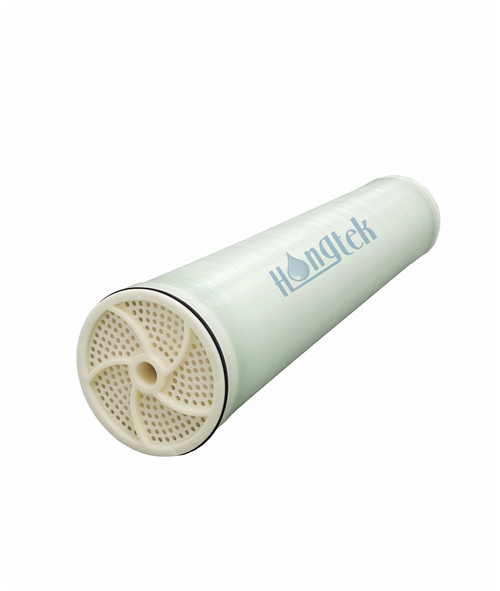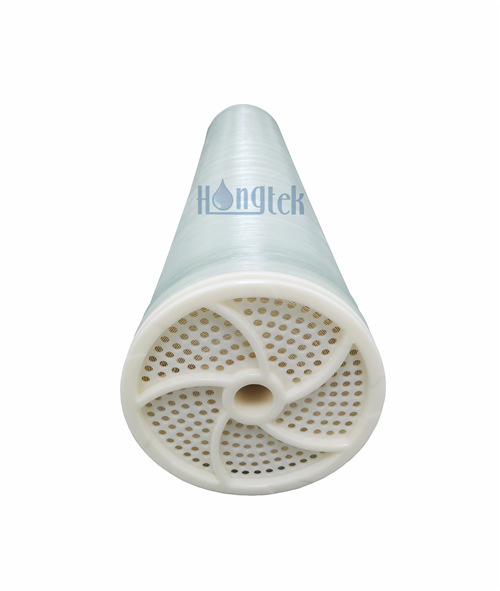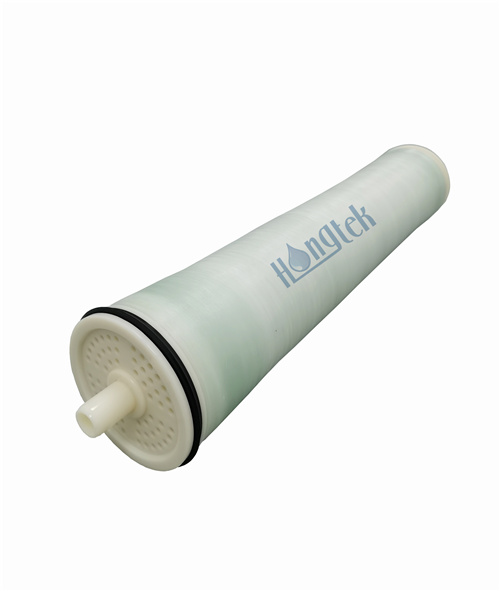


FR Series Fouling Resistant Industrial RO Membrane Elements adopt a special process to treat the membrane surface, which changes the charge and smoothness of the RO membrane surface, increases the hydrophilicity of the membrane surface, effectively reduces the fouling of colloids, organic matter and other dirt, and greatly improves the cleaning and recovery performance of the membrane. At the same time, a 34mil wide inlet flow channel design is adopted to further strengthen the anti-pollution ability of the RO membrane element and better cleanability. FR Series fouling resistant RO elements have the characteristics of high desalination rate and large flux. The RO membrane elements are suitable for the desalination of surface water, groundwater, tap water and municipal water with a salt content of less than 10,000ppm.
| Model | FR-4040 | FR-8040 |
| Effective Membrane Area ft²(m²) | 90(8.4) | 365(33.9) |
| Average Water Production GPD(m³/d) | 2200(8.3) | 9600(36.3) |
| Stabilized Desalination Rate % | 99.5 | 99.5 |
| Minimum Desalination Rate % | 99.3 | 99.3 |
| Membrane Media | Aromatic Polyamide | |
| Construction | Sprial Wound | |
| Test Pressure | 225psi (1.55MPa) | |
| Test Water Temperature | 25℃ | |
| PH Value of Test sSolution | 7.5 | |
| Test Solution Concentration (NaCl) | 2000ppm | |
| Recovery Rate of Single RO Element | 15% | |
● The salt removal rate of industrial fouling resistant RO elements can reach 99.5%
● The RO membrane elements can be used to treat sewage with a TDS of 2000-4000
● Long service life and economic cost, saving the cost of reverse osmosis water system
● The RO membrane elements have strong fouling resistant ability and better cleanability
● Industrial RO membranes are suitable for salt content of water sources below 10,000ppm
● Fouling resistant RO elements have the characteristics of high desalination rate and large flux
● Boiler make-up water
● Organic sewage treatment
● Industrial wastewater reuse
● High TDS sewage treatment
● Surface wastewater treatment
● Micro-polluted water treatment
RO Menbrane Elements Operating Limits and Conditions
| Production floating range | ±15% |
| Maximum feed water temperature | 45℃ |
| Maximum feed water SDI15 | 5 |
| Maximum influent turbidity NTU | 1 |
| Maximum residual chlorine concentration | 0.1ppm |
| Maximum Operating pressure | 600psi(4.14Mpa) |
| Maximum pressure drop of single membrane element | 15psi(0.1Mpa) |
| PH value range of feed water during continuous operation | 3~10 |
| PH value range of feed water during chemical cleaning | 2 ~12 |
| Maximum feed water flux | Model: 4040 - 16gpm(3.6m³/h) |
| Model: 8040 - 75gpm(17m³/h) |
Drawing Sizes of FR Series Industrial RO Membrane Elements
What is the difference between anti-fouling reverse osmosis membrane and ordinary reverse osmosis membrane elements?
Faced with ever-exposing water quality problems, the water treatment industry has been developing new equipment to address serious water pollution problems.The development of anti-pollution reverse osmosis membrane is a new breakthrough in water treatment industry technology. At present, anti-pollution RO membranes elements are widely used in all walks of life, Alleviate the problem of people's production and living water. However, many people still have doubts about the difference between fouling reverse osmosis membranes and ordinary reverse osmosis membranes. So what is the difference between anti-fouling reverse osmosis membrane and ordinary reverse osmosis membrane?
● Fouling resistant RO membrane is a process improvement of ordinary reverse osmosis membrane, so that it has stronger anti-pollution ability and can work efficiently in the environment with poor water inlet conditions.
● Compared with the conventional reverse osmosis membrane, the anti-fouling membrane has been improved in terms of membrane material, membrane surface roughness, membrane surface electrical properties, etc. Thus, the anti-pollution ability of the membrane element is improved, the frequency of chemical cleaning is reduced, and the cost of the operation process is saved.
● As a new type of membrane technology, fouling resistant RO membrane membrane is widely used in concentration, purification and separation projects, especially in wastewater recovery, in projects where ordinary reverse osmosis membranes cannot be applied, such as reclaimed water reuse.
● The anti-fouling reverse osmosis membrane is hardly affected by the adsorption of point substances such as surfactants. Different structure and The material greatly improves the anti-biological fouling performance of the reverse osmosis membrane element and ensures the stable operation of the reverse osmosis system
● Industrial fouling resistant RO element has good anti-pollution ability and cleaning characteristics, which greatly reduces the adsorption of bacteria and microorganisms on the membrane surface. The water supply channel is very wide, and the membrane material is hydrophilic, so the water flow rate is large.
If the anti-fouling ability of the reverse osmosis membrane is not strong, the membrane element needs to be replaced soon, which is not suitable from the perspective of water purification requirements or economic considerations. All in all, in order to ensure the water yield of the reverse osmosis membrane and achieve green and sustainable development, the anti-pollution ability of the reverse osmosis membrane is very important.
| Hongtek | FR Series Fouling Resistant RO Elements | Membrane Element Diameter | Length of Membrane Element |
| HT | FR | 40: 4" | 40: 40" |
| 80: 8" |
For example:
HT-FR-4040
Hongtek - FR Series Fouling Resistant RO Elements - Diameter: 4" - Length: 40"